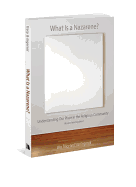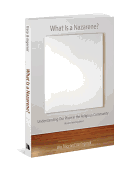What Is a Nazarene?: Understanding Our Place in the Religious Community (Revised, Updated)
What Is a Nazarene?: Understanding Our Place in the Religious Community (Revised, Updated)
198 in stock
Couldn't load pickup availability
Descriptions
Descriptions
The dream that drew the founders together was a believers church in the Wesleyan tradition. It is the same dream that guides the Church of the Nazarene today. But how does that translate into a world where denominational lines don t seem to matter as much as they used to?
Biographical Note:
Dr. Wes Tracy has been a leader and teacher in Adult Education projects on four continents. He has served the Church as pastor, teacher, author, and editor. Tracy holds five degrees, including two master's degrees and two academically earned doctorates. The former editor of eight Christian periodicals, he has published 1,500 articles and is the author or co-author of more than 20 books including The Upward Call, Here We Stand, and, Reflecting God. Stan Ingersol has been the Nazarene Archives manager since 1985. He wrote Nazarene Roots: Prophets, Pastors, Revivalists & Reformers and is a co-author of Our Watchword & Song: The Centennial History of the Church of the Nazarene. He has written for many Nazarene publications, the Wesleyan Theological Journal, Methodist History, and several theological dictionaries and encyclopedias. For ten years he was a Nazarene delegate on the World Methodist Council. His spouse, Rev. Cheryl Somers-Ingersol, is a pastor in Overland Park, Kansas.
Marc Notes:
Includes bibliographical references (p. ).
Table of Contents:
Introduction: A Spiritual Home -- Part 1. Who are the Nazarenes? -- 1. They Shared a Dream: The Launching of the Nazarene Movement -- 2. What Nazarenes Believe and Practice -- Part 2. Our Closest Kin: The Methodist and Holiness Churches -- 3. Early Wesleyan Foundations -- 4. American Methodists -- 5. Our Sister Denominations: The Holiness Churches -- Part 3. The Liturgical Churches -- 6. The Eastern Orthodox Churches -- 7. The Roman Catholic Church -- Part 4. Classical Protestant Churches -- 8. The First Protestants: Lutherans Rearrange the Christian World -- 9. Calvin's Kin: Presbyterians and Reformed Churches -- 10. Catholic and Reformed: The Anglican Paradox -- Part 5. The Tradition of the Believers Church -- 11. The Peace Churches: Anabaptists, Brethren, and Quakers -- 12. The Baptists: A Priesthood of Believers -- 13. Unity and Simplicity: The Christian Church (Disciples of Christ) -- Part 6. The Pentecostal and Charismatic Churches -- 14. The Pentecostals and Charismatics -- 15. Nazarenes in Dialogue with the Pentecostals and Charismatics -- Appendix: Nazarene Articles of Faith, The Church (including Agreed Statement of Belief and The Covenant of Christian Character) -- Notes.
Publisher Marketing:
Around the turn of the 19th century, the Holiness Movement blossomed in America. Wesleyan-Holiness denominations sprang up all over the country. In 1907-8, five of these joined together to form the Church of the Nazarene.The dream that drew the founders together was a believers church in the Wesleyan tradition. It is the same dream that guides the Church of the Nazarene today. But how does that translate into a world where denominational lines don t seem to matter as much as they used to? How is a Nazarene different from a Presbyterian, Baptist, or Pentecostal brother or sister in Christ? What is a Nazarene? answers those questions in concise, easy-to-understand terms, as it examines the similarities and differences between the Church of the Nazarene and other mainline Christian denominations. With refreshing insight and candor, What is a Nazarene? will acquaint you with the heritage that birthed a vision that made a dream come true.
Share

